
Kappo Sato
Kappo Sato is a refined Japanese restaurant serving Kappo cuisine on Mount Pleasant Road.
Meaning to cut and to cook in Japanese, Kappo is a multi-course meal where the chef connects directly with the guest.
Unlike most other specialties, Kappo chefs aren't just experts in preparing dishes using quality seasonal ingredients, but also in Japanese food culture, including tea ceremony and flower arrangement culture.
It usually takes 10 to 15 years of training to acquire the range of skills required to be a master of Kappo.
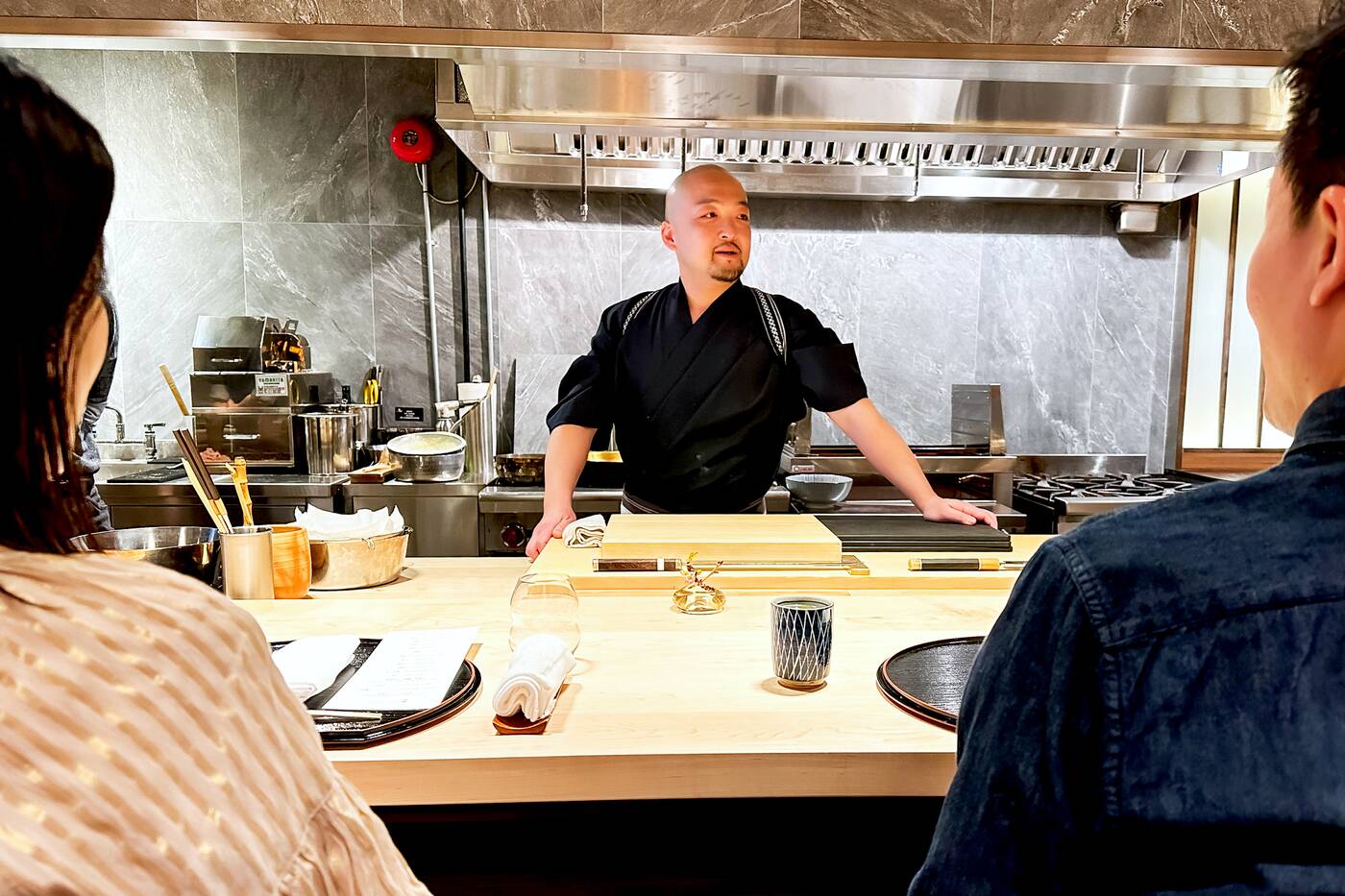 Chef-owner Takeshi Sato has more than 20 years of experience as a high-level Japanese chef who is also a qualified tea ceremony, flower arrangement, sommelier, and sake master.
Chef-owner Takeshi Sato has more than 20 years of experience as a high-level Japanese chef who is also a qualified tea ceremony, flower arrangement, sommelier, and sake master.
Prior to his stint as the official chef of the Japanese Consulate General in Toronto, he worked at a Michelin-starred restaurant in Tokyo before moving to Canada in 2011.
In 2013, Sato took on the head chef role at Zen Japanese Restaurant before branching out on his own with the support of his mentor and former employer Seiichi Kashiwabara, owner of Zen and Zen Sanuki Udon.
 "I wanted to have an open kitchen to make everything very fresh and ready to eat to serve directly to the customer as soon as it's made," Sato tells blogTO. "And it's not behind a kitchen where no one can see the dish being made."
"I wanted to have an open kitchen to make everything very fresh and ready to eat to serve directly to the customer as soon as it's made," Sato tells blogTO. "And it's not behind a kitchen where no one can see the dish being made."
Sato's attention to detail and meticulousness can be appreciated in everything from the quality of the food he prepared in front of guests from an open-facing counter to their presentation of carefully selected dishware from Baccarat crystal to handmade items commissioned from traditional Japanese potters.
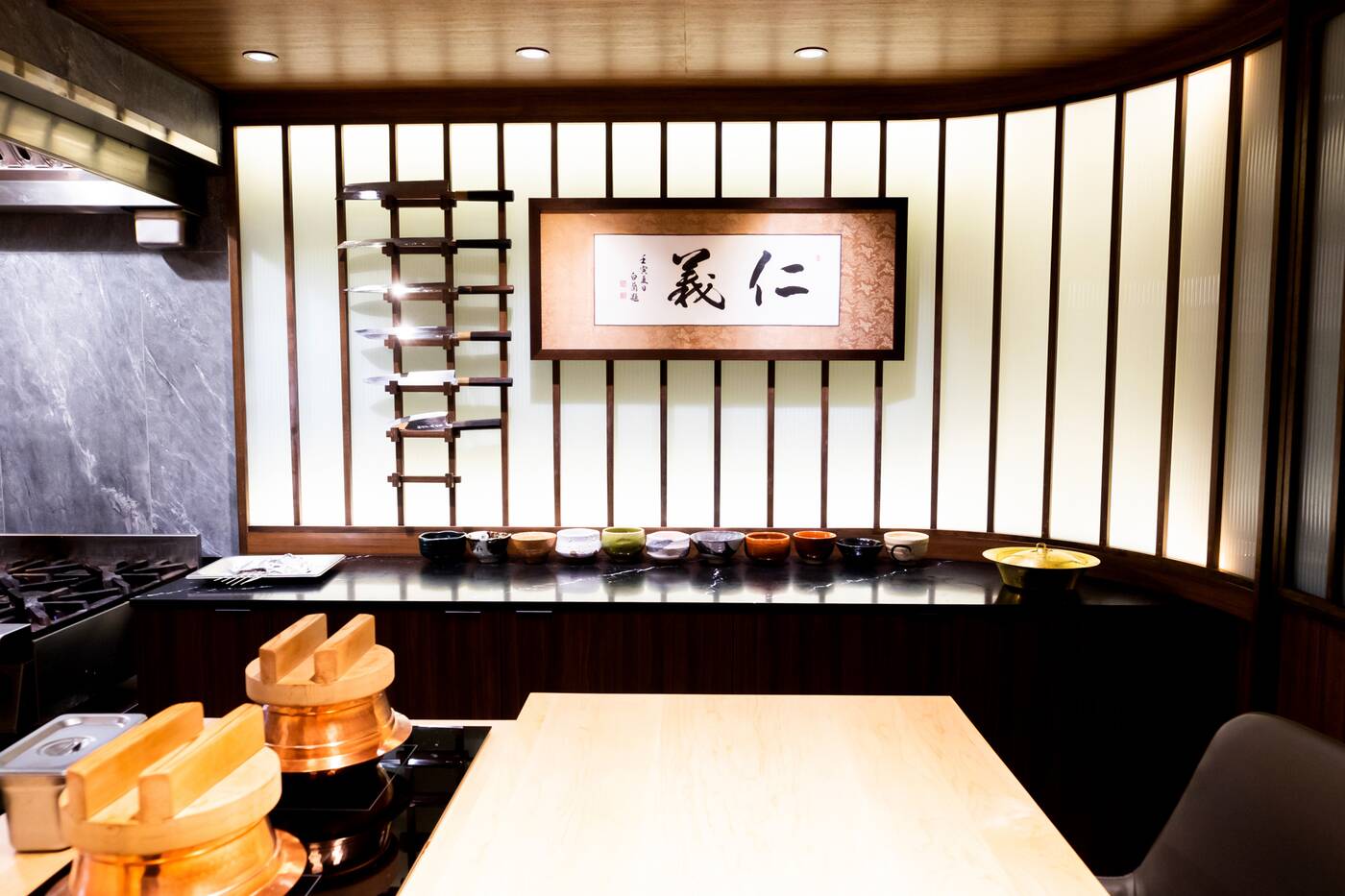 Even the room's décor – a relaxed, contemporary space that Sato helped design - and the imported specialized cooking equipment were chosen with intention.
Even the room's décor – a relaxed, contemporary space that Sato helped design - and the imported specialized cooking equipment were chosen with intention.
 The latter includes a fire-less grill with ceramic briquettes and a gunmetal pot commissioned from the last gunmetal pot production studio in Japan with a high thermal conductivity that is perfect for frying tempura.
The latter includes a fire-less grill with ceramic briquettes and a gunmetal pot commissioned from the last gunmetal pot production studio in Japan with a high thermal conductivity that is perfect for frying tempura.
 To ensure they deliver a perfect experience for their guests, Kappo only serves eight people per seating and offers only two seatings a night.
To ensure they deliver a perfect experience for their guests, Kappo only serves eight people per seating and offers only two seatings a night.
Dining options consist of two omakase menus priced at a spendy $260 and $320. Depending on the season, the menu might feature anything from 12 to 16 courses.
Unique to season offerings might include everything from firefly squid in spring to hamo (conger eel) in summer, with many items procured through a buyer Sato has direct contact with at a fish market in Japan.
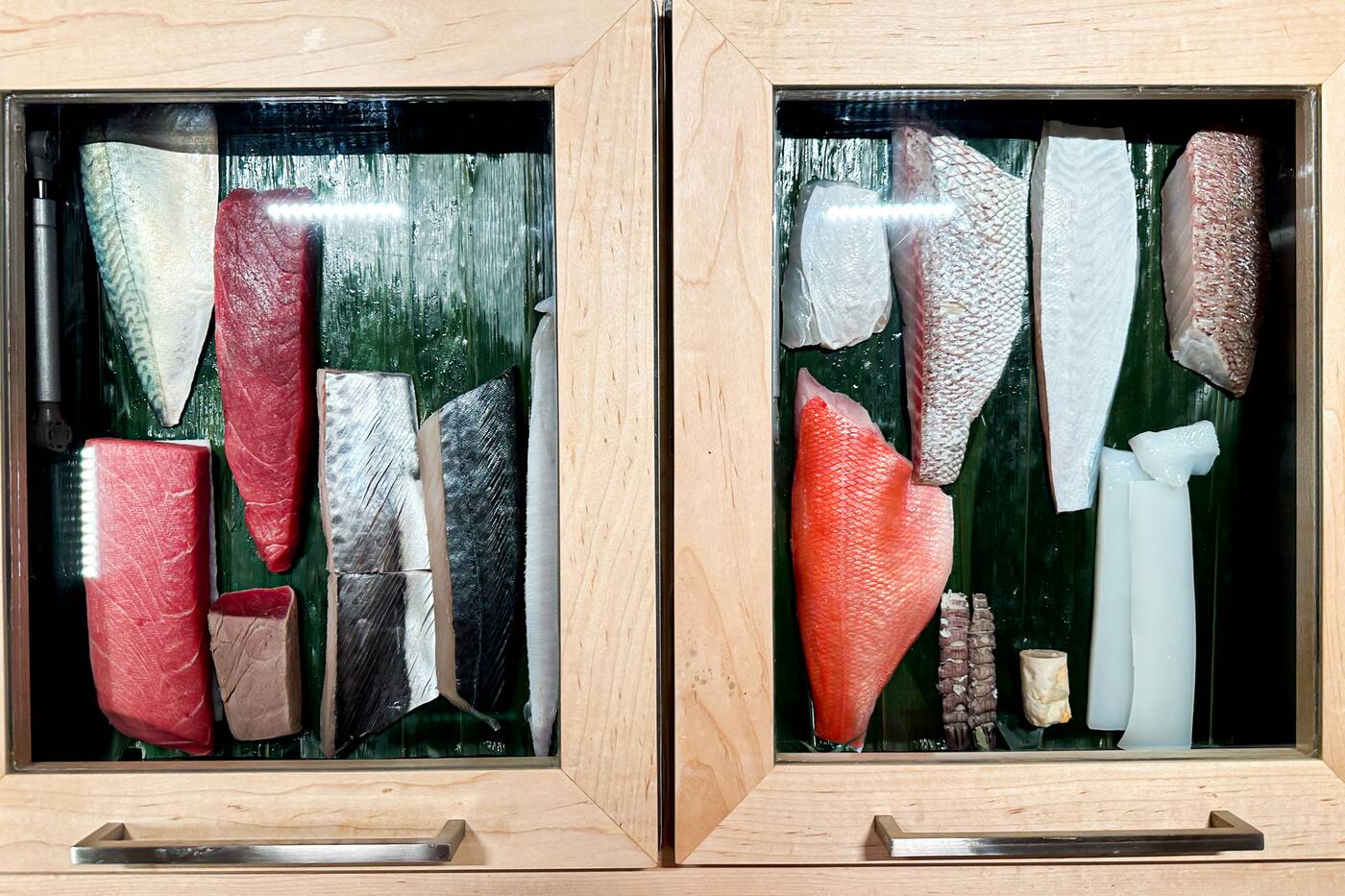 Everything presented, however, is thoughtful and features a parade of premium ingredients like wagyu beef, and rounded out with pristine plates of sushi, sashimi, tempura, plus broiled and grilled dishes.
Everything presented, however, is thoughtful and features a parade of premium ingredients like wagyu beef, and rounded out with pristine plates of sushi, sashimi, tempura, plus broiled and grilled dishes.
The $320 menu has extra courses including sake-steamed kichiji (rockfish) fish and uses prized cuts and the best ingredients.
There are also sake pairings, $120 or $200 for the premium experience, that's expertly selected by the restaurant's sake master and sommelier. Teas are available.
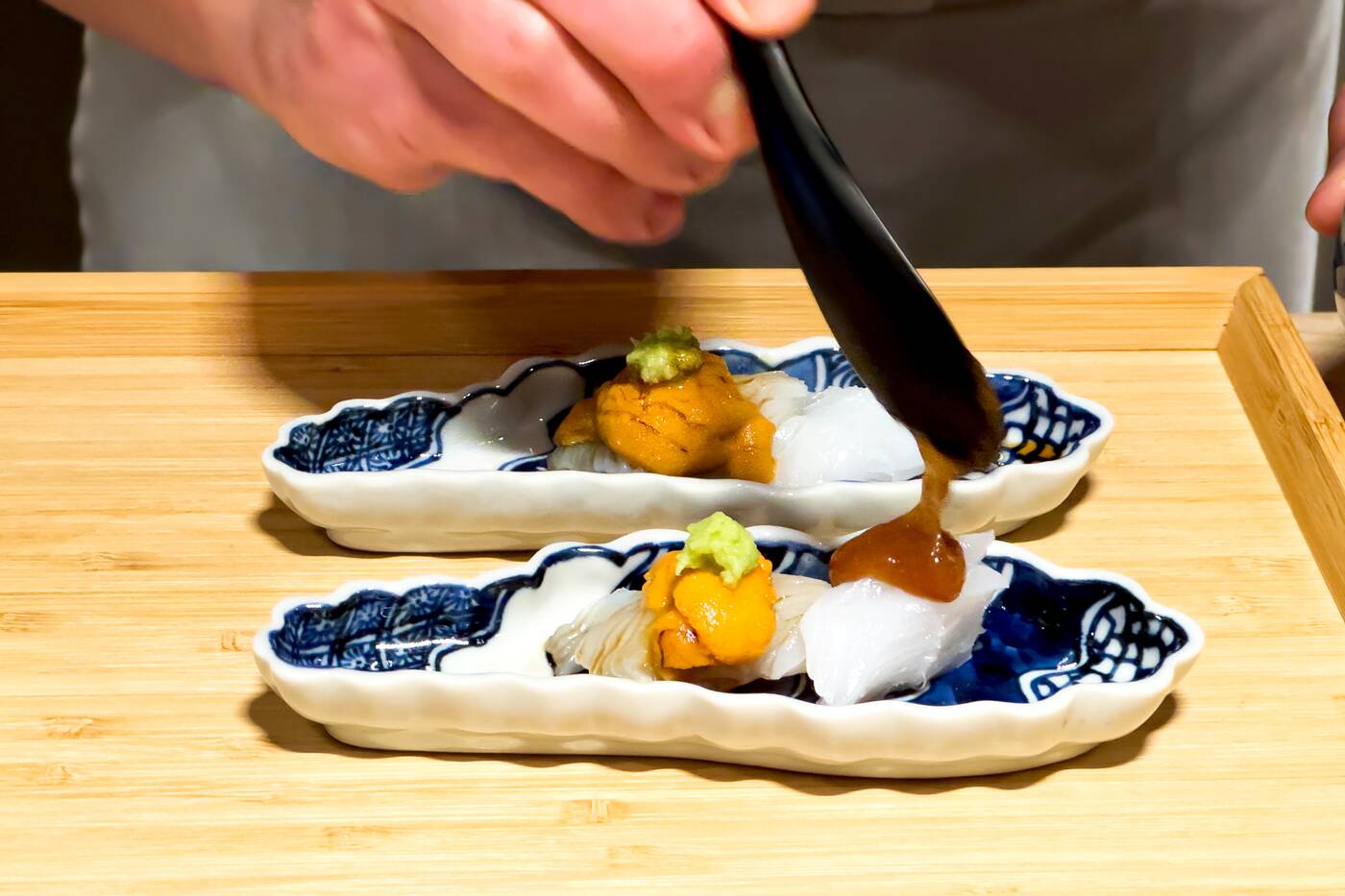 The omakase starts with a flight of courses including an appetizer plater which may feature a selection of sashimi such as creamy ika (squid) from Portugal and Hokkaido uni (sea urchin) topped with fresh wasabi.
The omakase starts with a flight of courses including an appetizer plater which may feature a selection of sashimi such as creamy ika (squid) from Portugal and Hokkaido uni (sea urchin) topped with fresh wasabi.
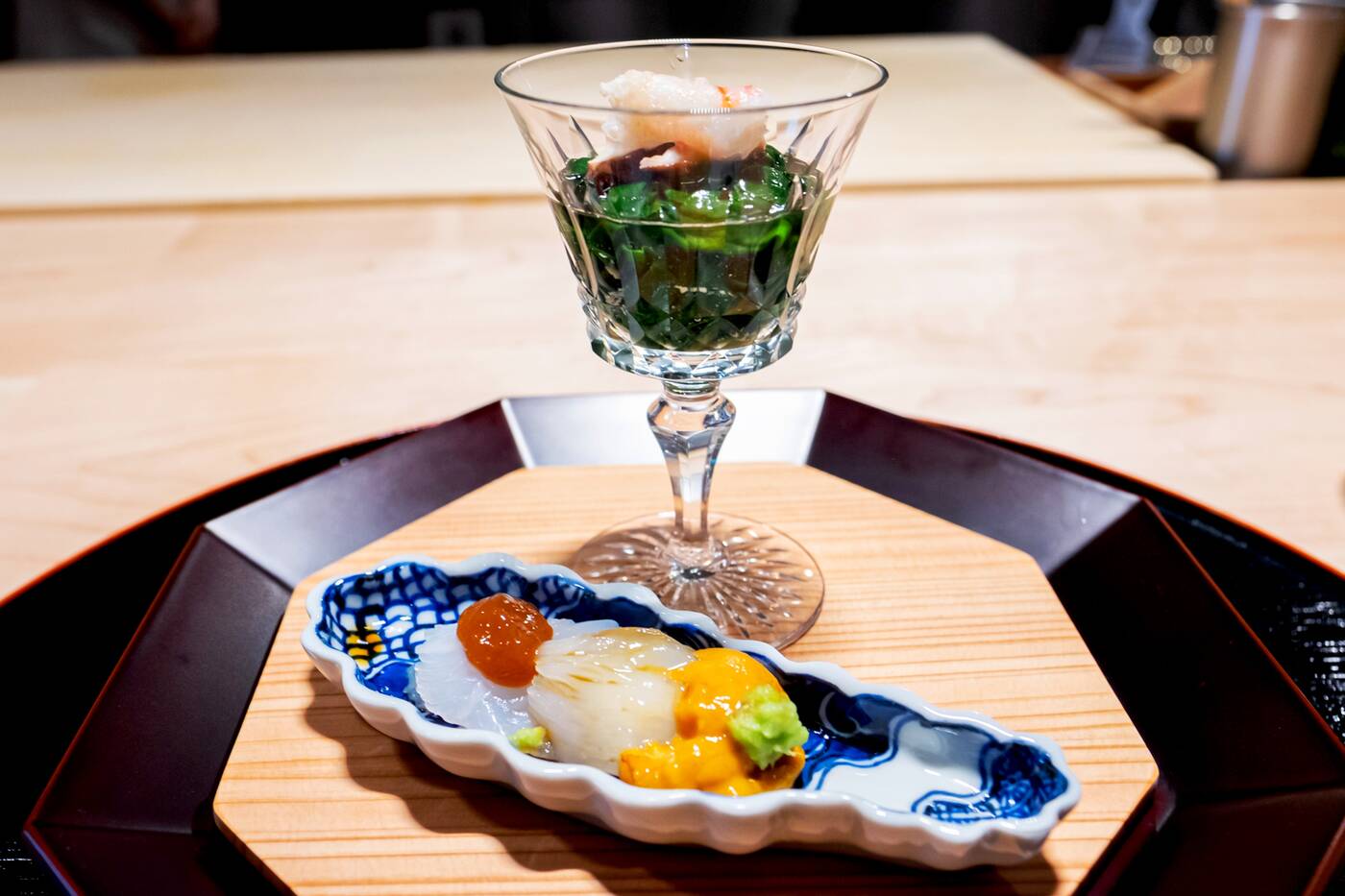 The sashimi plate is sided by a refreshing and bright ohitashi made of spinach, chrysanthemum flower and shiitake mushrooms that's capped with Alaskan snow crab.
The sashimi plate is sided by a refreshing and bright ohitashi made of spinach, chrysanthemum flower and shiitake mushrooms that's capped with Alaskan snow crab.
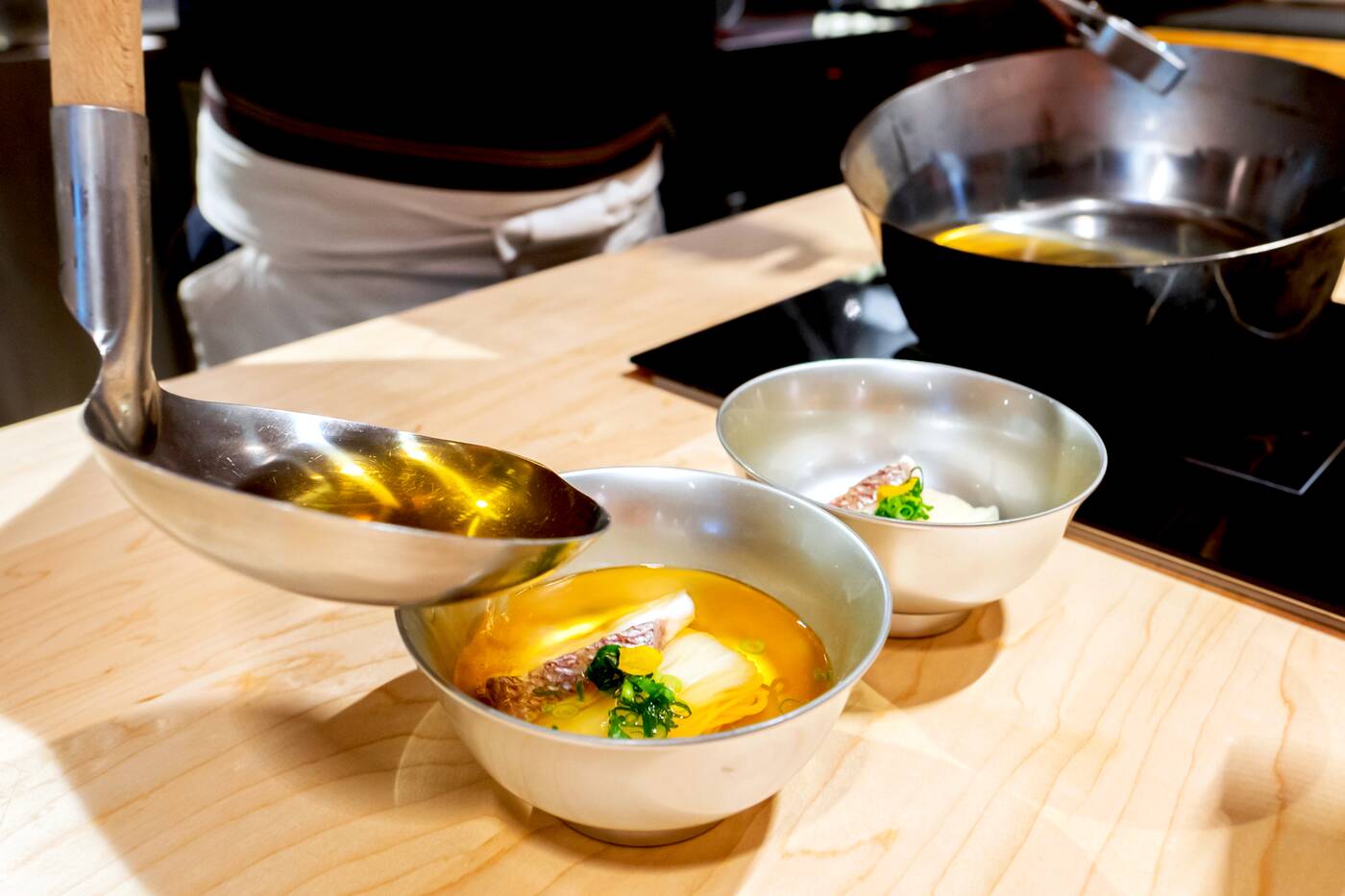 Soup is considered a test of a chef's technique, and one of the most difficult things to make. For the dashi used in his Nyumen (soup) course, Sato uses kombu from Hokkaido and freshly shaven dried bonito from the Kagoshima Prefecture that's done to order.
Soup is considered a test of a chef's technique, and one of the most difficult things to make. For the dashi used in his Nyumen (soup) course, Sato uses kombu from Hokkaido and freshly shaven dried bonito from the Kagoshima Prefecture that's done to order.
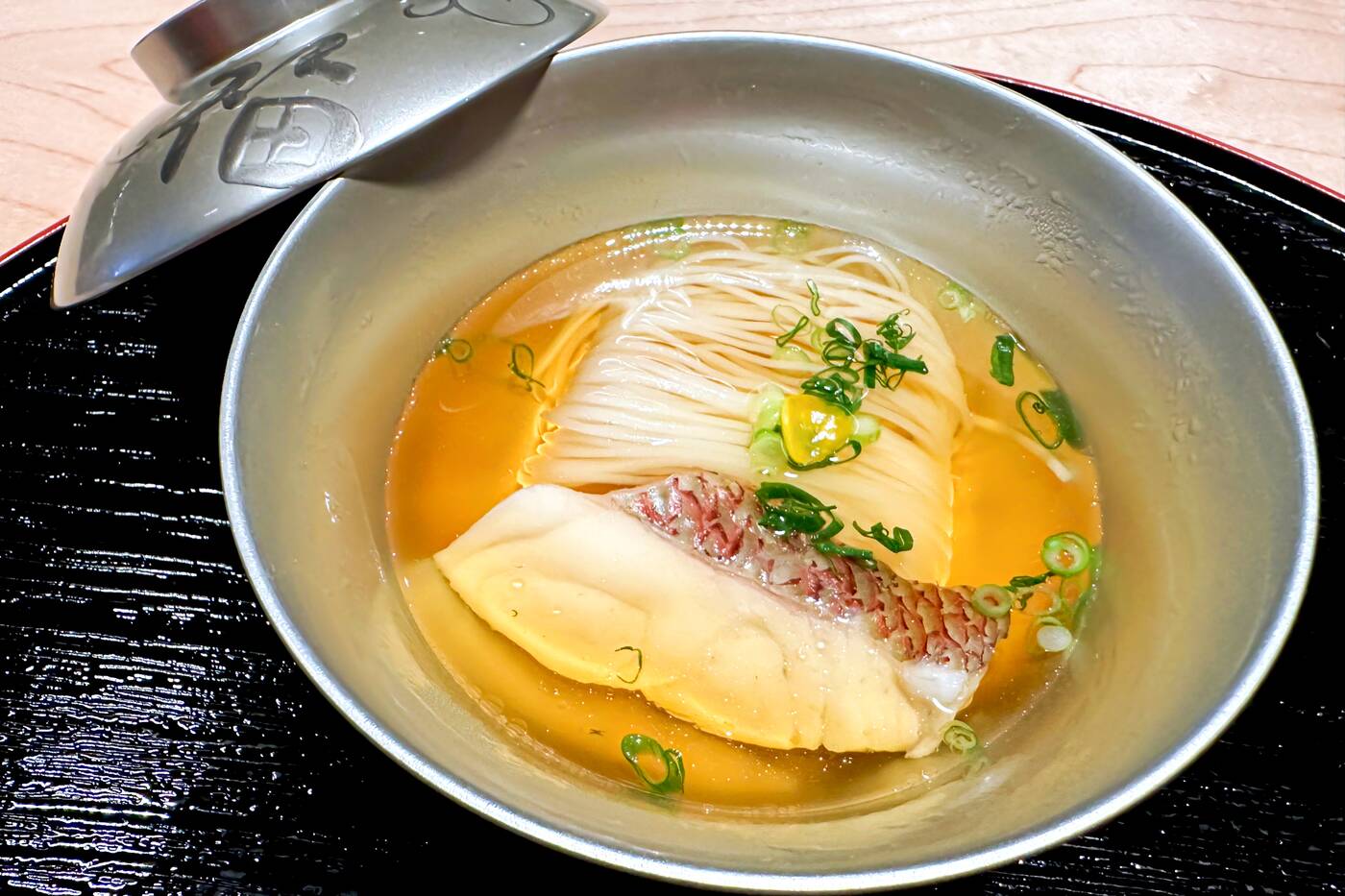 Not only is the visual mesmerizing, but the flavours and pleasing aroma that comes from the steeped fresh bonito is bright, clean yet subtle, and full of umami. Silky somen noodles and a delicate filet of tai (sea bream).
Not only is the visual mesmerizing, but the flavours and pleasing aroma that comes from the steeped fresh bonito is bright, clean yet subtle, and full of umami. Silky somen noodles and a delicate filet of tai (sea bream).
 The Tempura course is served by the piece with DIY seasoning with ponzu, sea salt, and lemon.
The Tempura course is served by the piece with DIY seasoning with ponzu, sea salt, and lemon.
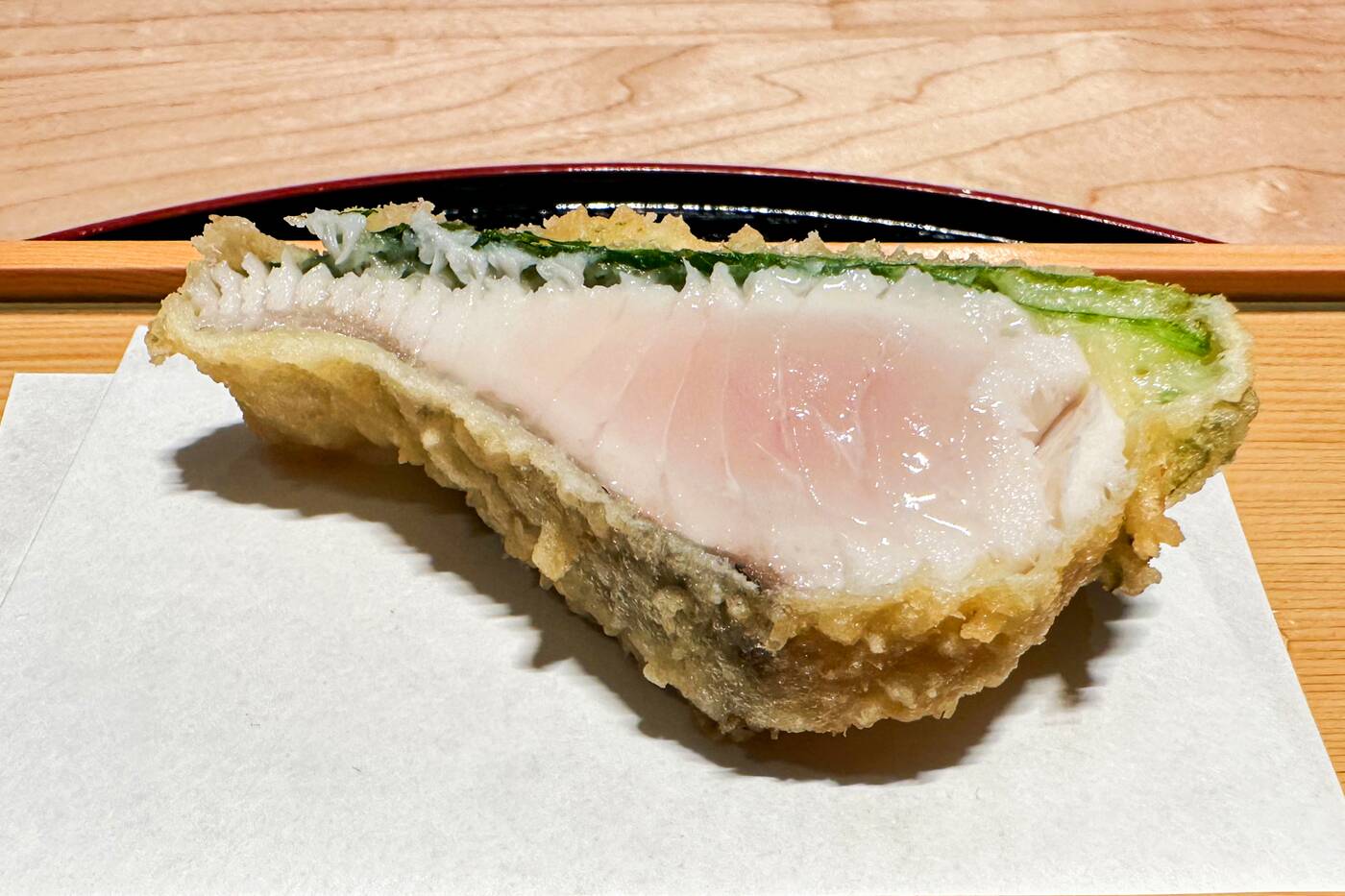 The daily changing selection might feature a perfect spear of asparagus, followed by a supple piece of oba shiso leaf-wrapped sashimi-grade Spanish mackerel that's shielded by a light and crisp batter. The latter is cooked to a beautiful medium-rare finish.
The daily changing selection might feature a perfect spear of asparagus, followed by a supple piece of oba shiso leaf-wrapped sashimi-grade Spanish mackerel that's shielded by a light and crisp batter. The latter is cooked to a beautiful medium-rare finish.
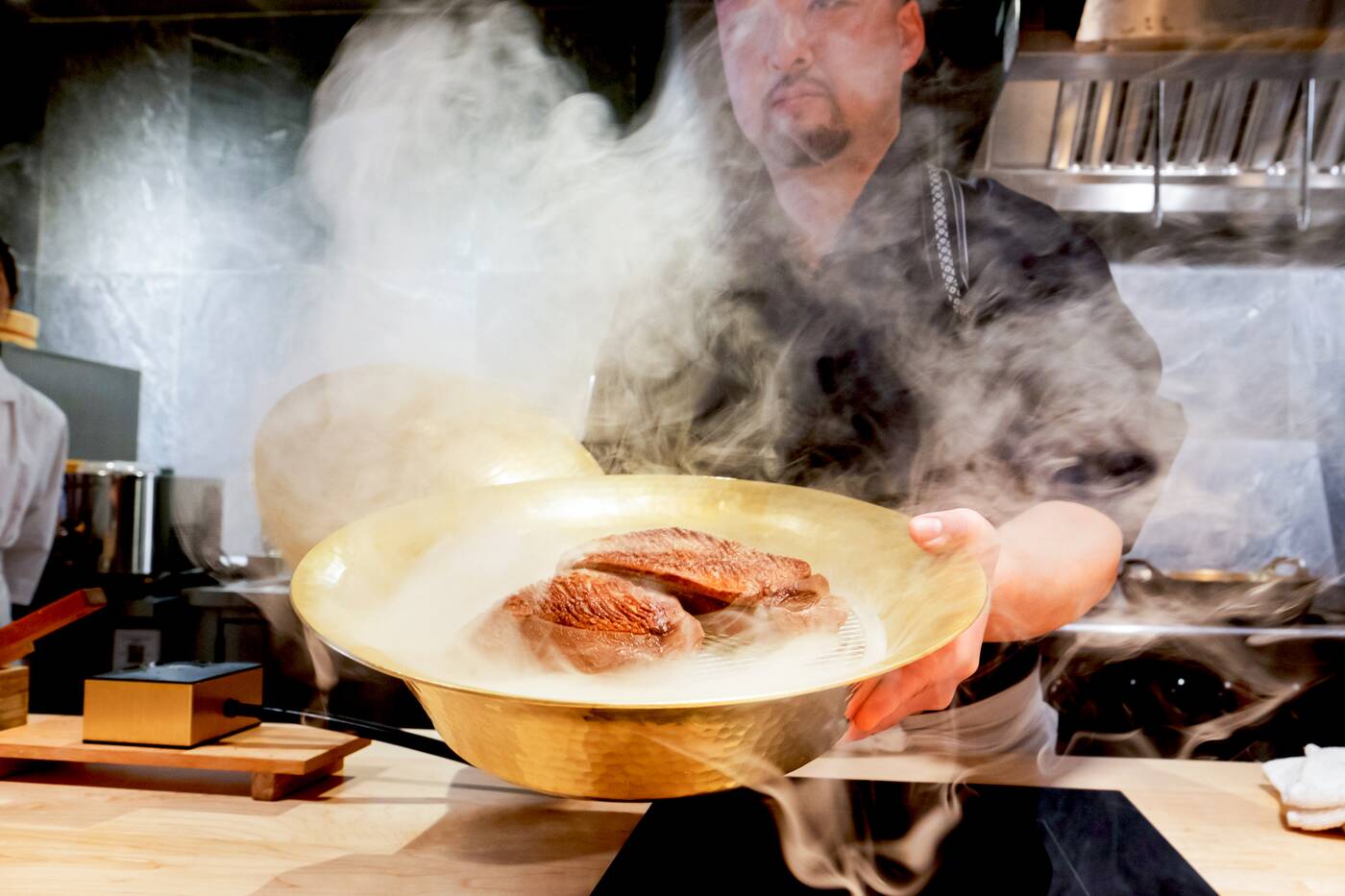 The Broiled Smoked Dish may feature Quebec duck breast that's been smoked with Sakura (cherry blossom) wood chips and topped with a miso-flavoured sauce.
The Broiled Smoked Dish may feature Quebec duck breast that's been smoked with Sakura (cherry blossom) wood chips and topped with a miso-flavoured sauce.
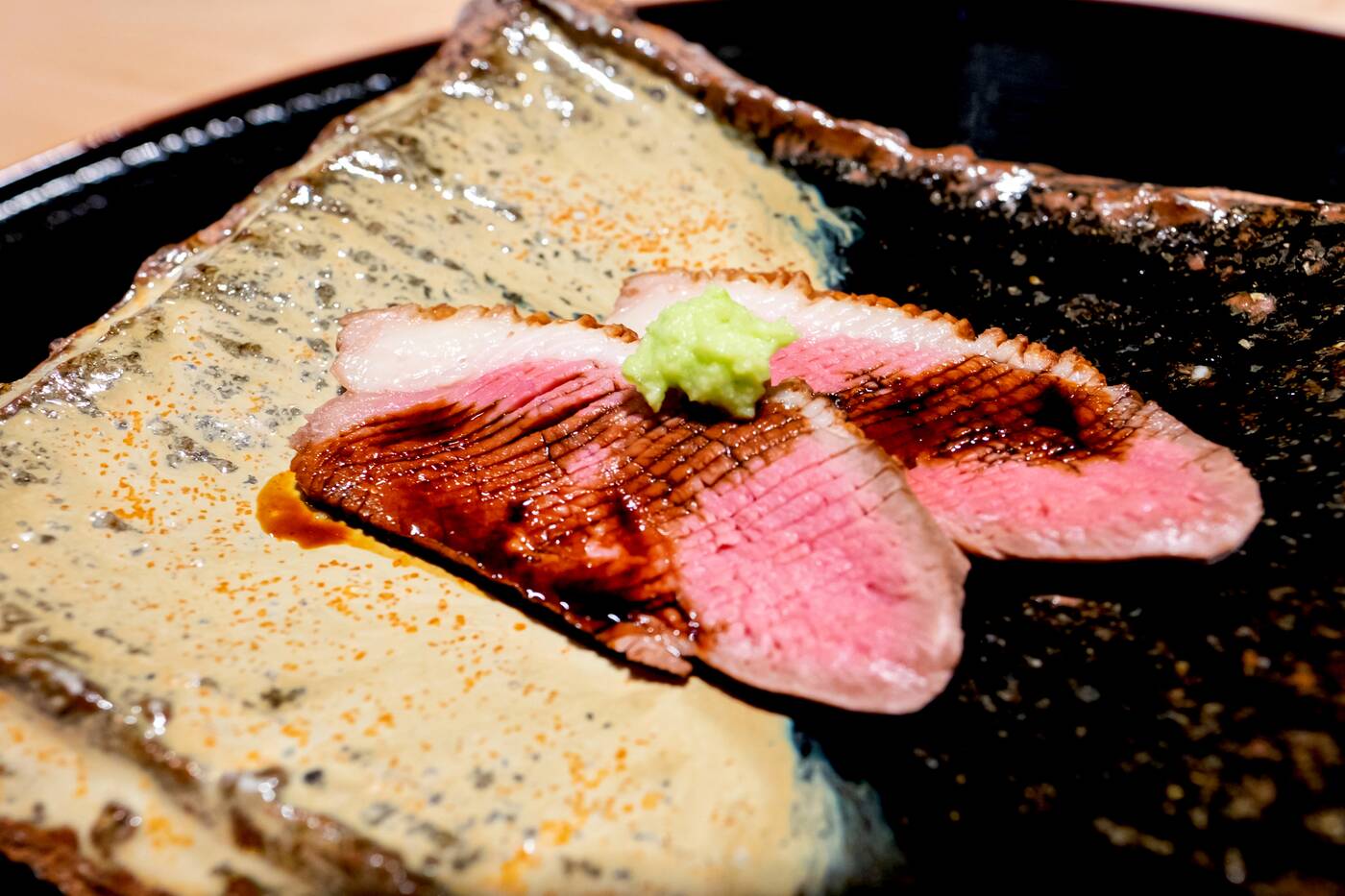 The sweet, smoky and lean flesh is supple and packed with umami.
The sweet, smoky and lean flesh is supple and packed with umami.
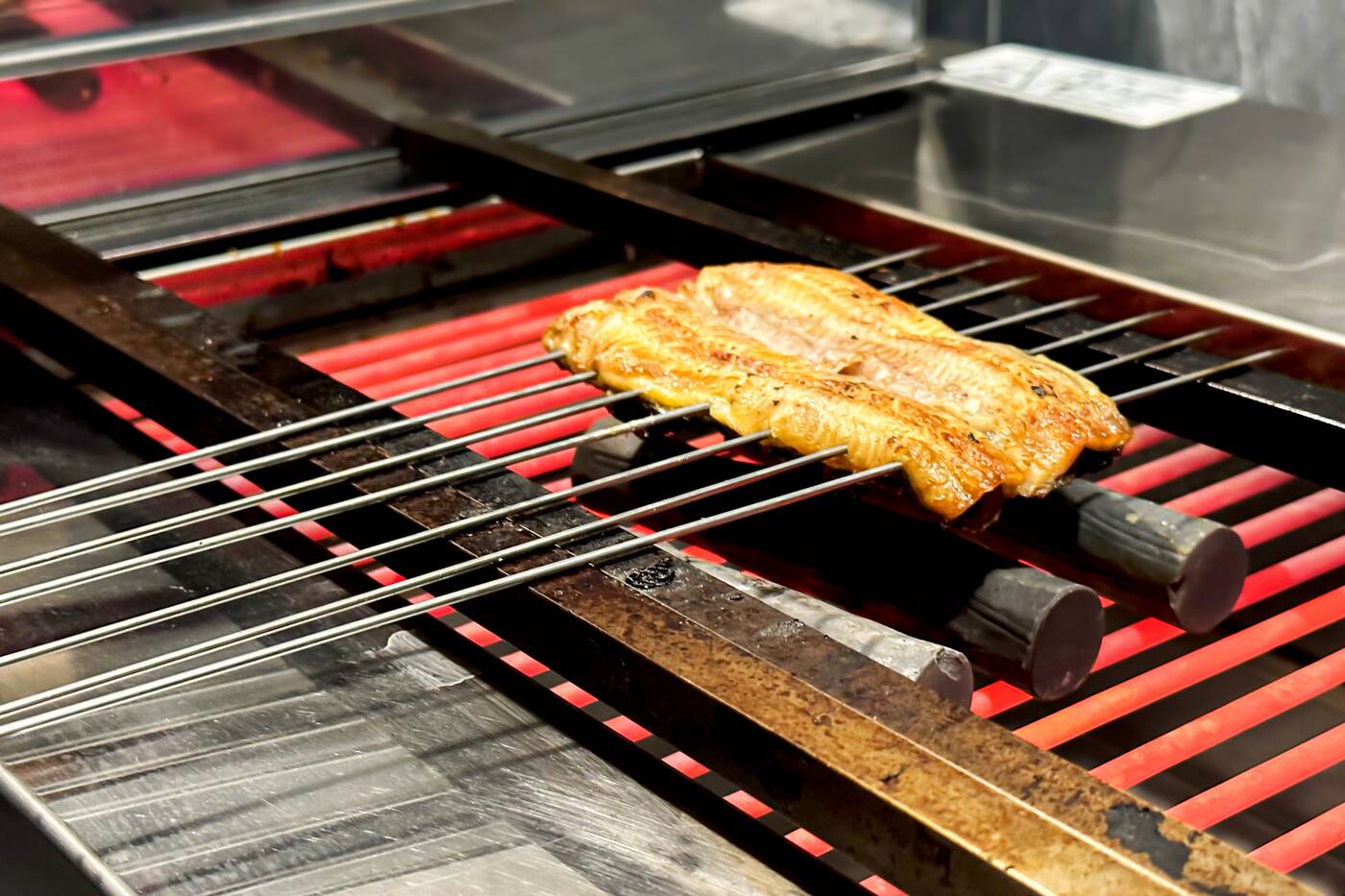 Grilled Dish might feature unagi (freshwater eel) from Aichi prefecture that's been grilled over high heat holding ceramic briquettes.
Grilled Dish might feature unagi (freshwater eel) from Aichi prefecture that's been grilled over high heat holding ceramic briquettes.
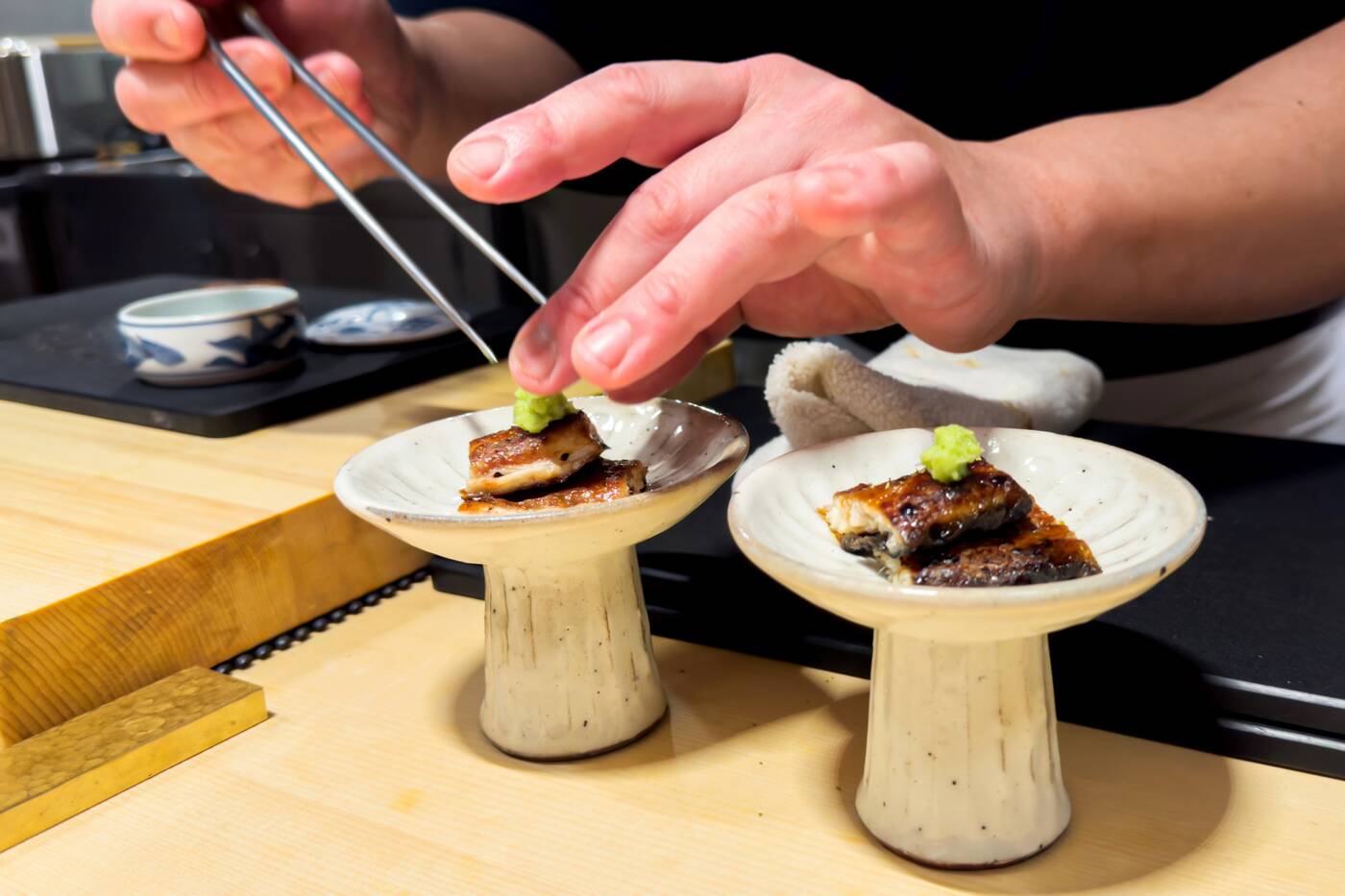 The golden, blistered flesh isn't singed by flames and results in this almost crisp crust that hides the moist, and almost creamy, flavourful flesh below. Think a cream puff in texture but clean and savoury flavours that's slicked with homemade kabayaki sauce.
The golden, blistered flesh isn't singed by flames and results in this almost crisp crust that hides the moist, and almost creamy, flavourful flesh below. Think a cream puff in texture but clean and savoury flavours that's slicked with homemade kabayaki sauce.
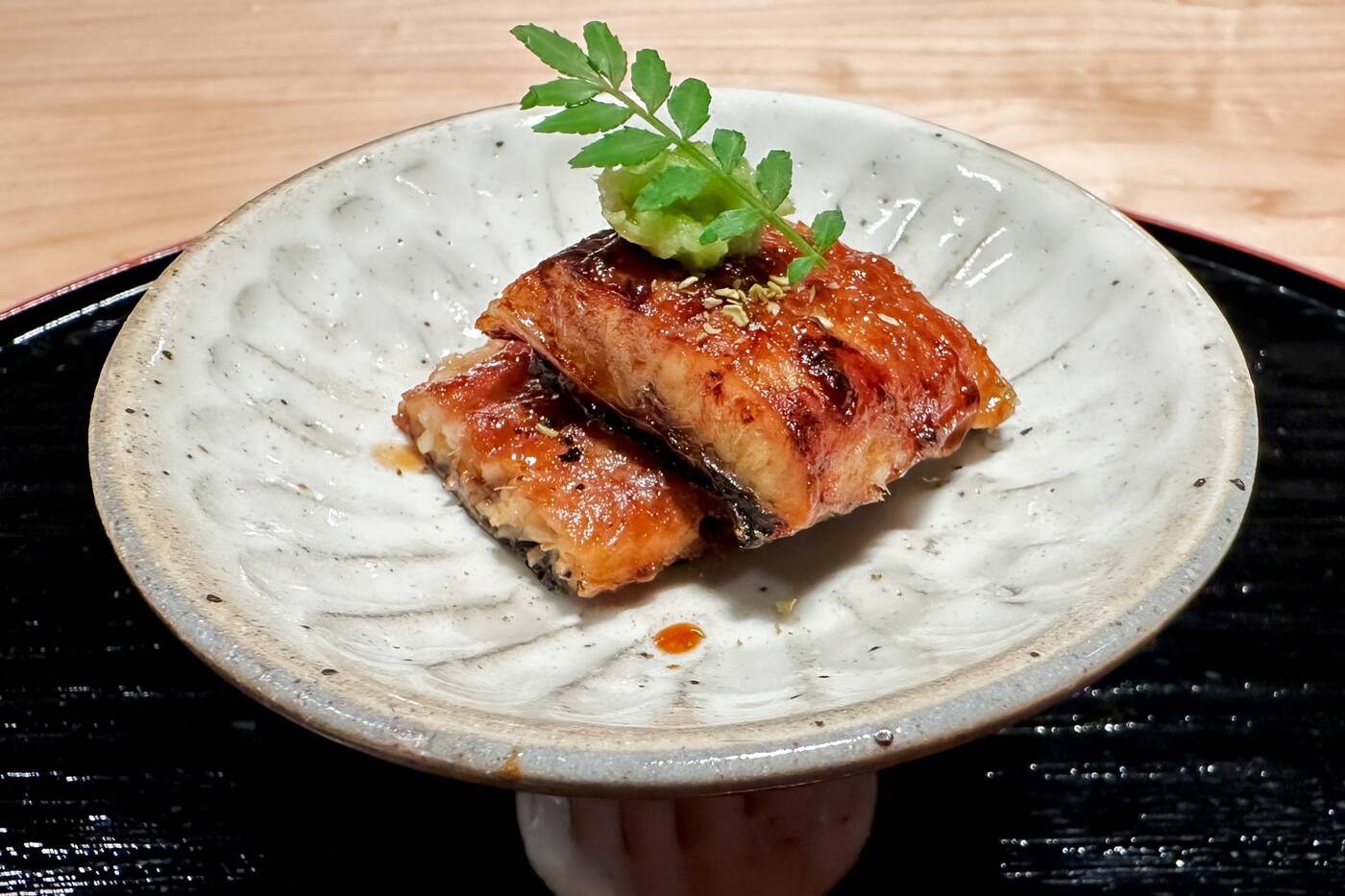 The rich flavours of the grilled fish dish, along with the sweet-savoury soy sauce and mirin-based sauce is cut by the additional fresh wasabi and kinome (sansho pepper leaf) garnish. It's simply ethereal.
The rich flavours of the grilled fish dish, along with the sweet-savoury soy sauce and mirin-based sauce is cut by the additional fresh wasabi and kinome (sansho pepper leaf) garnish. It's simply ethereal.
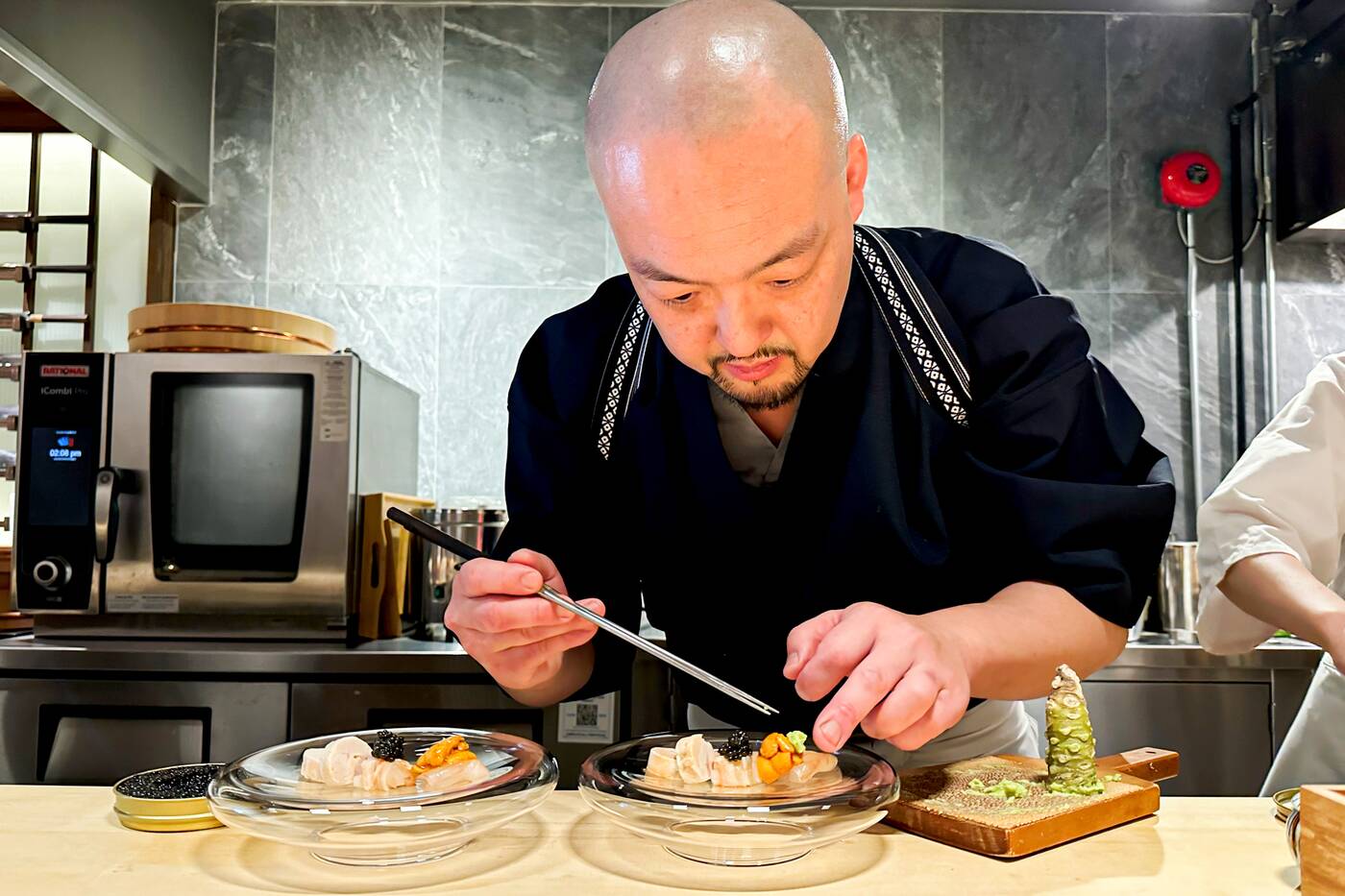 The Seasonal Fish Dish on this visit featured Hokkaido hirame (fluke) topped with uni and fresh wasabi, Canadian lobster topped with osetra caviar, and ankimo (monkfish liver) that's garnished with miso paste and yuzu zest.
The Seasonal Fish Dish on this visit featured Hokkaido hirame (fluke) topped with uni and fresh wasabi, Canadian lobster topped with osetra caviar, and ankimo (monkfish liver) that's garnished with miso paste and yuzu zest.
 There is no question of quality in the premium selection of fish offered. Every morsel is divine, from the creamy sweet uni to the lush and rich ankimo that's cut by the bright floral yuzu zest.
There is no question of quality in the premium selection of fish offered. Every morsel is divine, from the creamy sweet uni to the lush and rich ankimo that's cut by the bright floral yuzu zest.
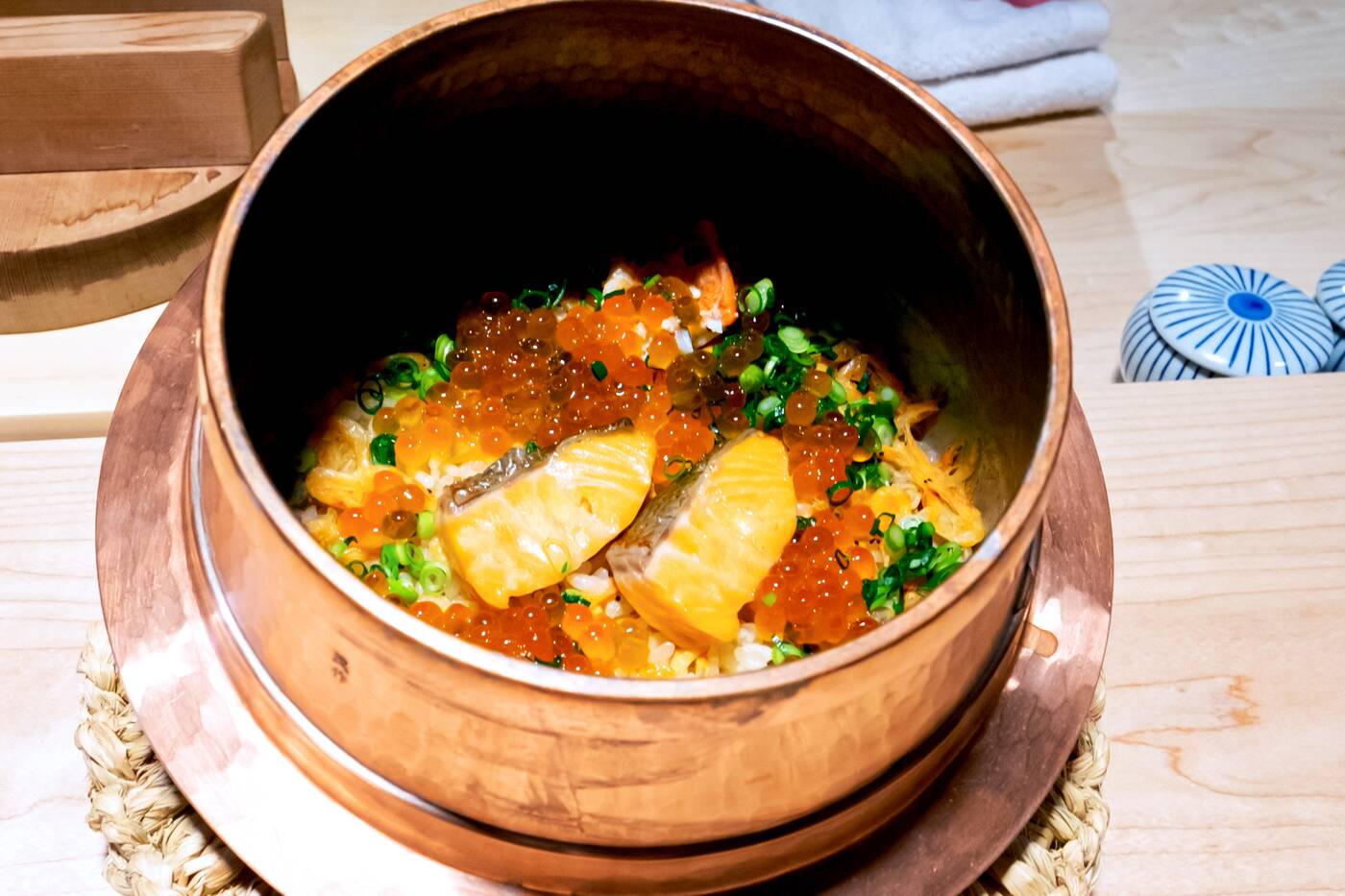 The restaurant's signature dish is the Seafood Pot-cooked Rice that's prepared in a special copper Hagama that's made by a master craftsman in Kyoto. Sato explains that it has high heat conductivity, which means he can cook rice with a small amount of dashi in a short time in it.
The restaurant's signature dish is the Seafood Pot-cooked Rice that's prepared in a special copper Hagama that's made by a master craftsman in Kyoto. Sato explains that it has high heat conductivity, which means he can cook rice with a small amount of dashi in a short time in it.
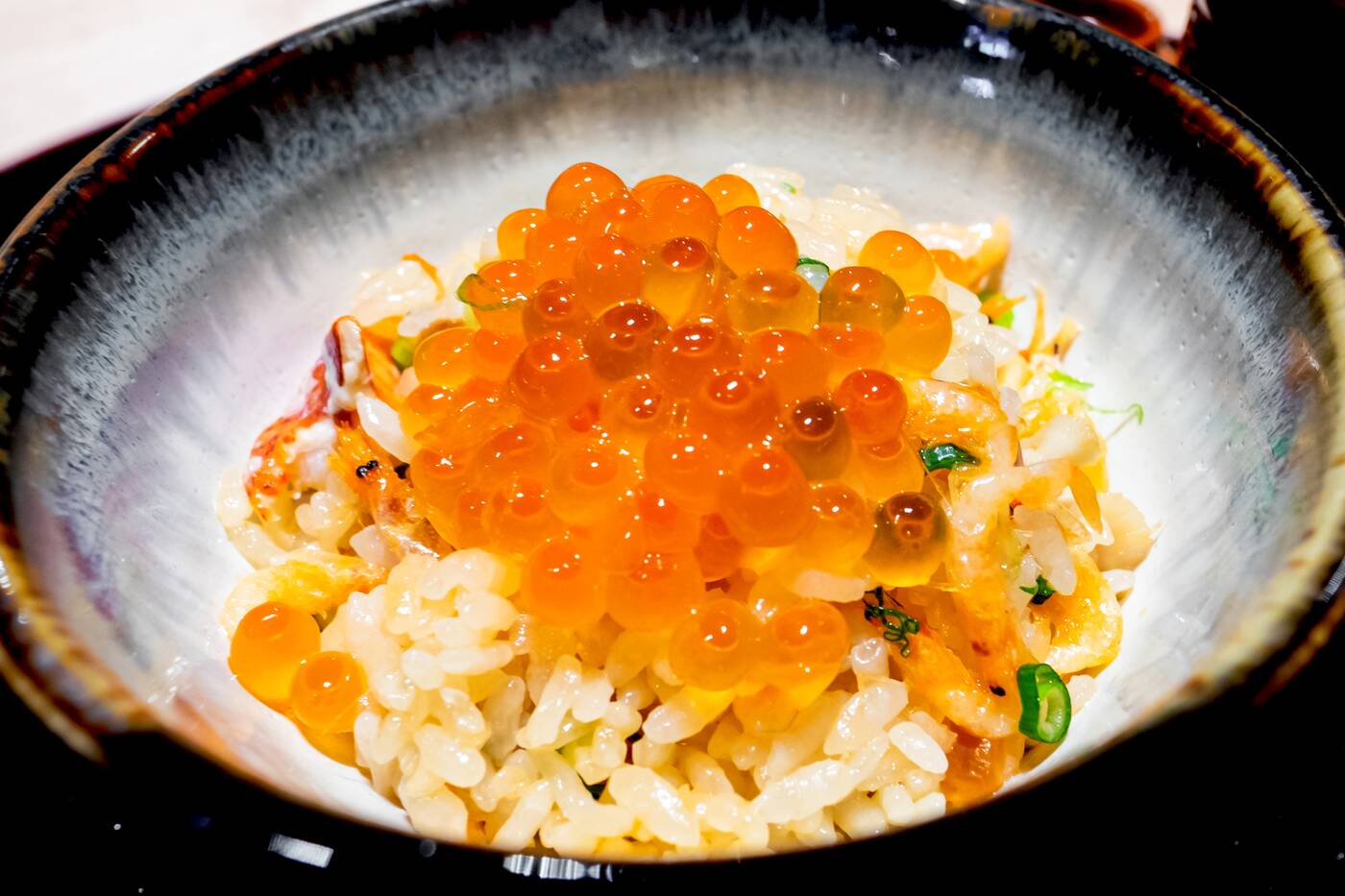 The resulting grains have a luster and firmness, plus sweet fragrant flavour from the clams and Sakura shrimp that's added to the pot. The rice pot is embellished with lobster and grilled ocean trout from Scotland before it's mixed then topped with ikura (salmon roe).
The resulting grains have a luster and firmness, plus sweet fragrant flavour from the clams and Sakura shrimp that's added to the pot. The rice pot is embellished with lobster and grilled ocean trout from Scotland before it's mixed then topped with ikura (salmon roe).
 The rice course is served with a serving miso soup that's equally well made that's aromatic and finessed.
The rice course is served with a serving miso soup that's equally well made that's aromatic and finessed.
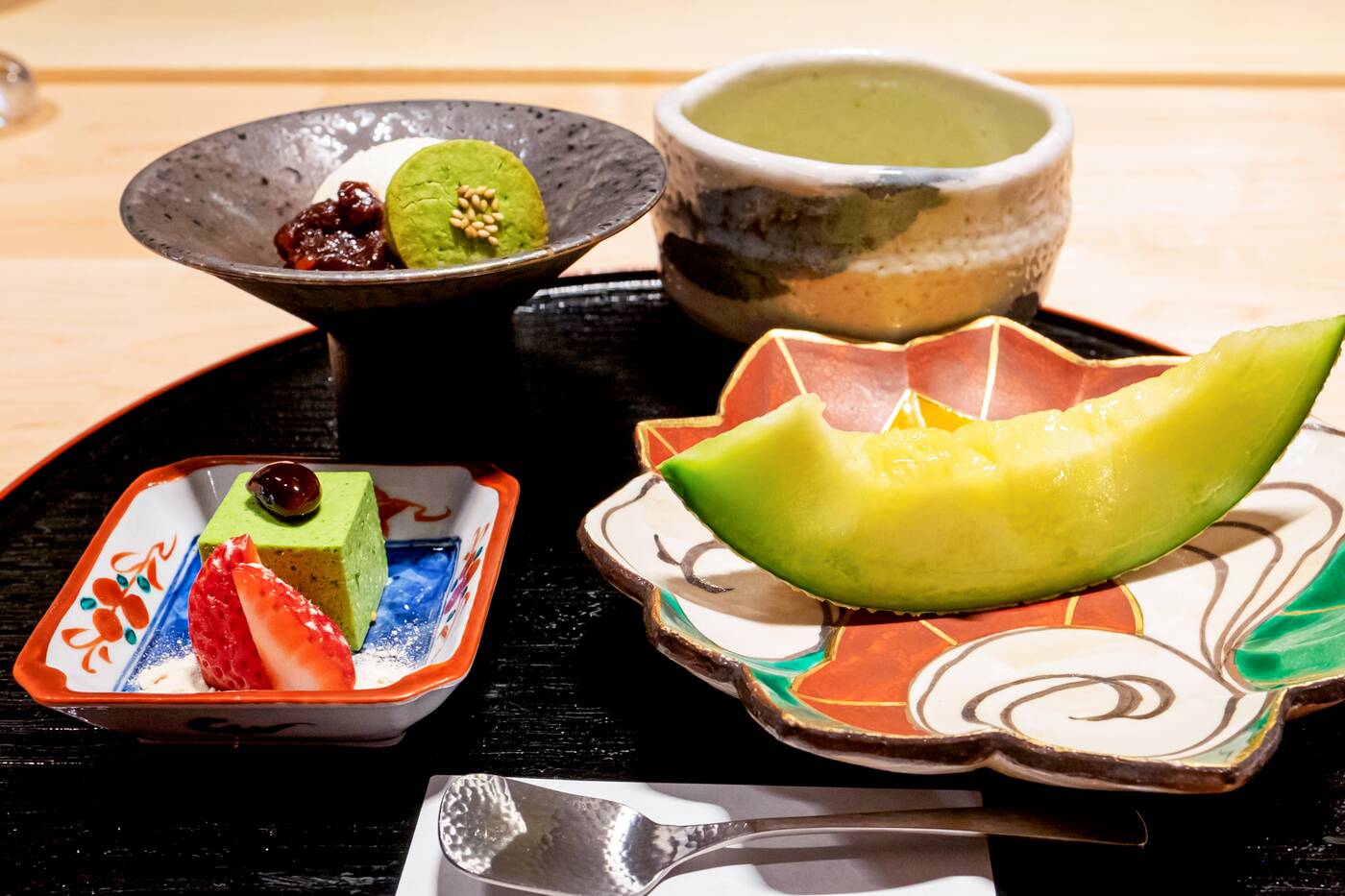 For the Fruit from Japan course, the seasonal treat might even be a show-stopping wedge of Japanese musk melon. The pricy fruit is a rare treat and features succulent flesh that bursts of juicy, honeyed melon flavour packed into each bite.
For the Fruit from Japan course, the seasonal treat might even be a show-stopping wedge of Japanese musk melon. The pricy fruit is a rare treat and features succulent flesh that bursts of juicy, honeyed melon flavour packed into each bite.
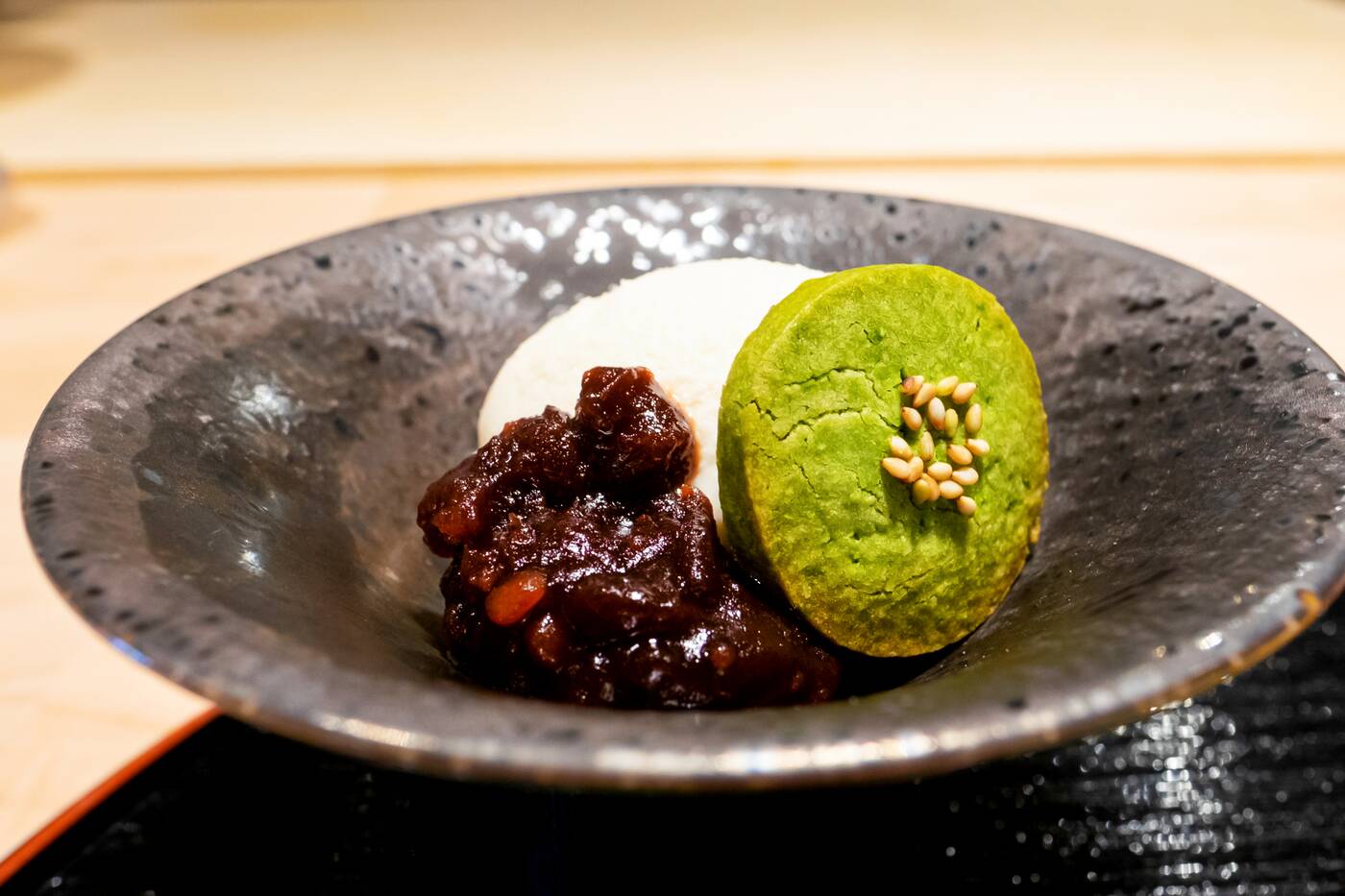 Sato's Homemade Ice Cream course featured a fresh and mild soya milk-flavoured frozen dessert topped with azuki (red) bean paste and matcha shortbread cookie. The course was served with kuromitsu (Japanese brown sugar syrup).
Sato's Homemade Ice Cream course featured a fresh and mild soya milk-flavoured frozen dessert topped with azuki (red) bean paste and matcha shortbread cookie. The course was served with kuromitsu (Japanese brown sugar syrup).
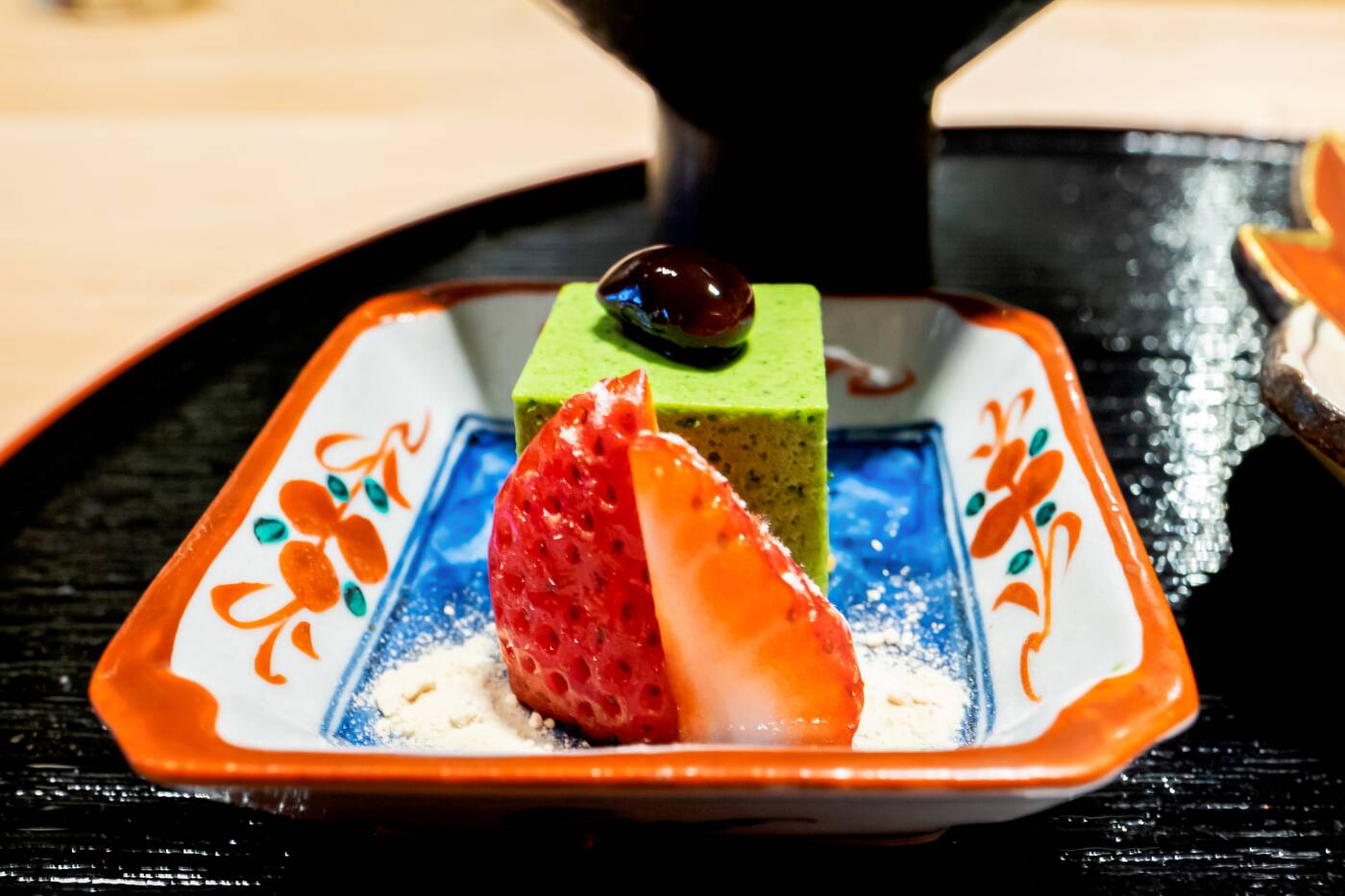 The flight of fanciful dishes concludes with homemade Matcha Mousse Cake crowned with a single immaculate kuromame (sweet black soybean). The latter is made through a three-day process and the result is a toothsome and delightful nugget of flavourful pleasure.
The flight of fanciful dishes concludes with homemade Matcha Mousse Cake crowned with a single immaculate kuromame (sweet black soybean). The latter is made through a three-day process and the result is a toothsome and delightful nugget of flavourful pleasure.
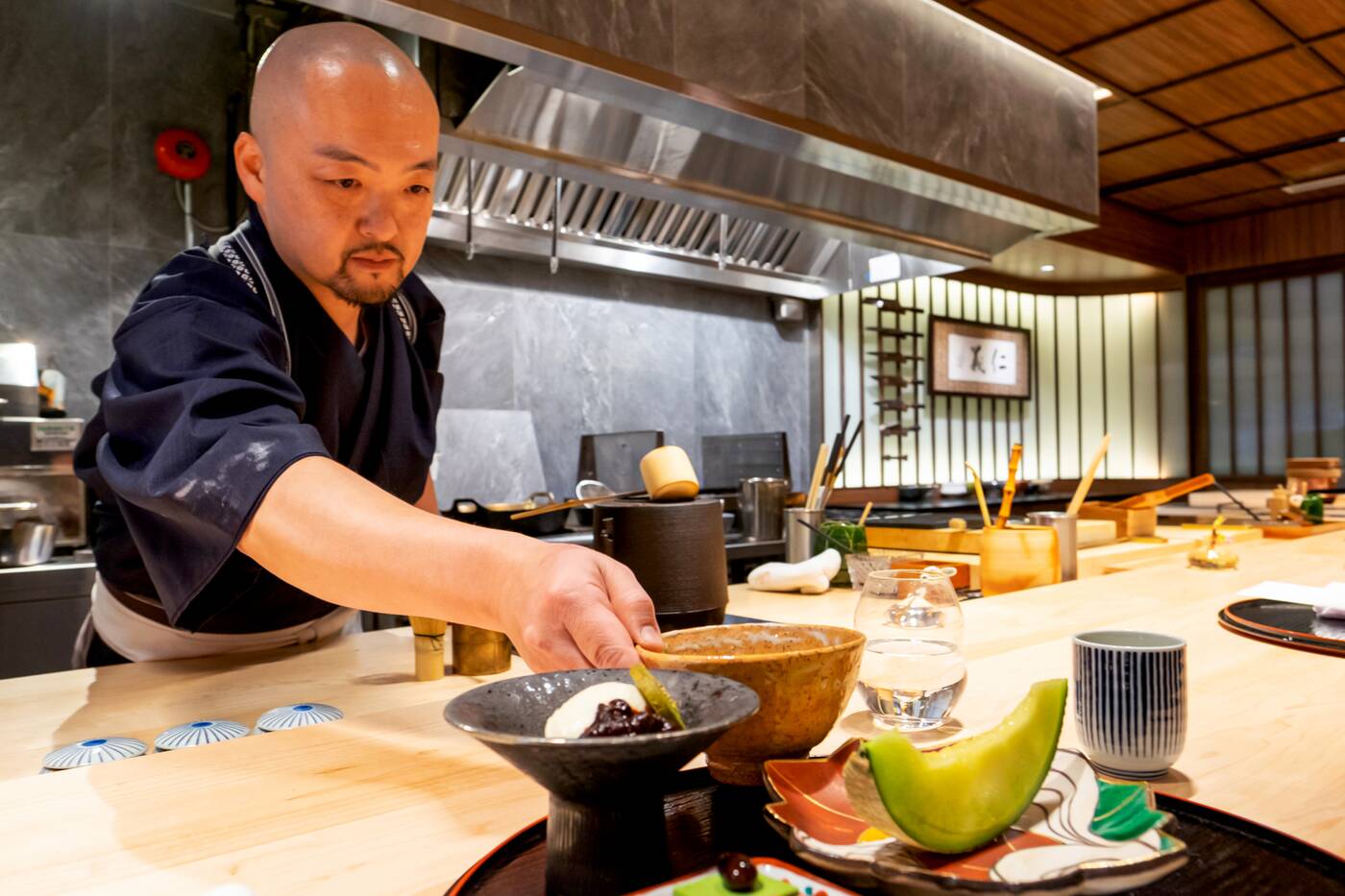 This final course is served with Matcha Tea that Sato prepares via tea ceremonial preparation for each guest. It's a rare and unique experience in the city that wraps up the meal in an elegant and traditional way.
This final course is served with Matcha Tea that Sato prepares via tea ceremonial preparation for each guest. It's a rare and unique experience in the city that wraps up the meal in an elegant and traditional way.
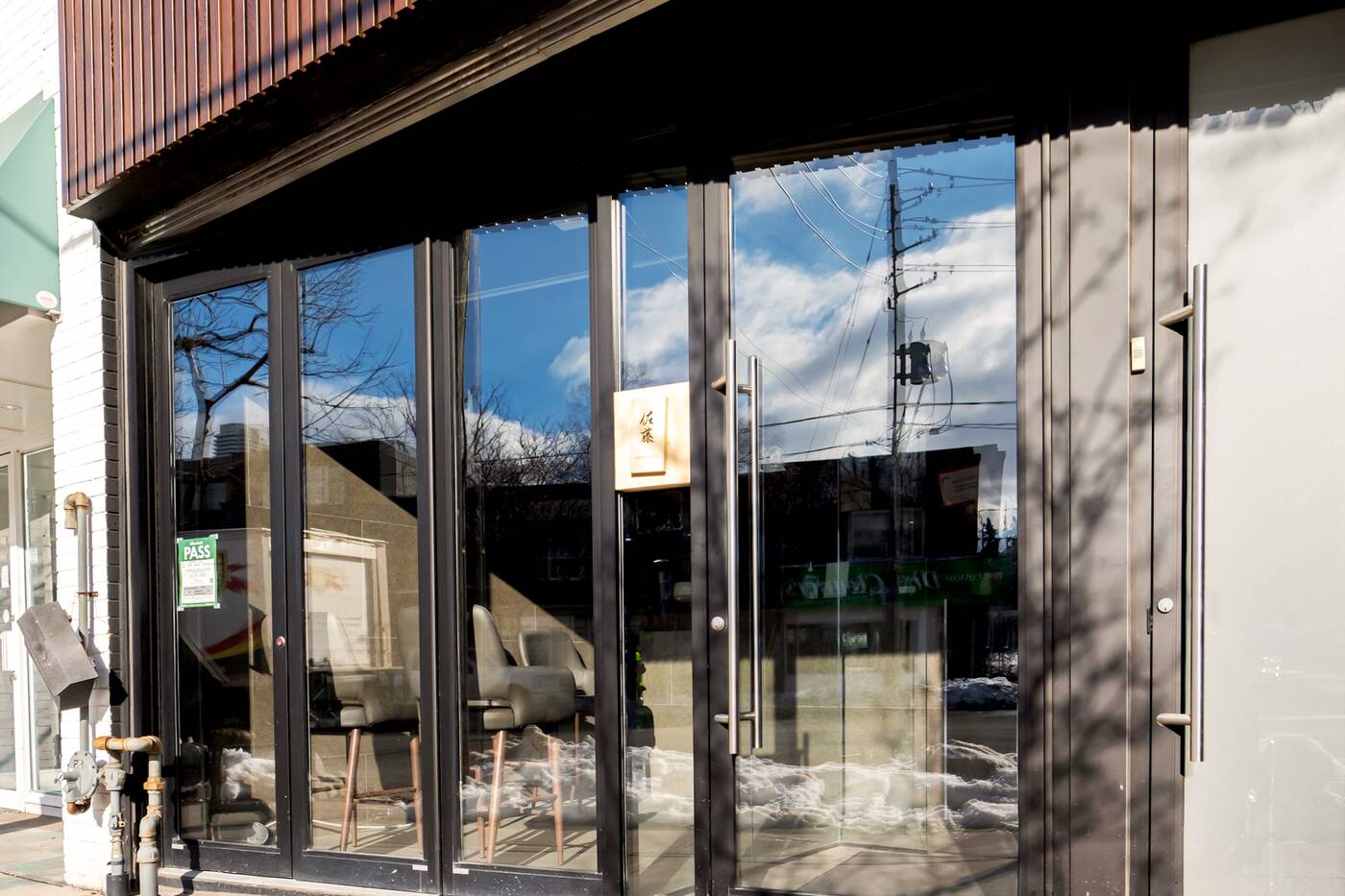 Experience Kappo cuisine south of Manor Road East on Mt Pleasant Road.
Experience Kappo cuisine south of Manor Road East on Mt Pleasant Road.
Renee Suen








